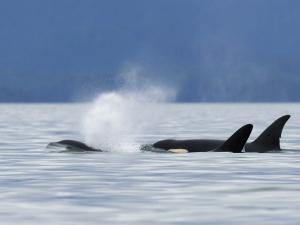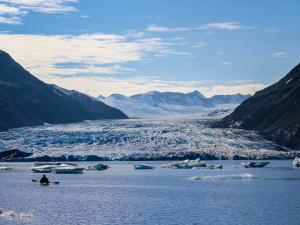Chugach National Forest
Known as the outdoor playground for half of Alaska's residents, Chugach National Forest attracts more than one million visitors a year.
Only a third as large as Tongass National Forest, its twin in the Inside Passage, Chugach is still the second-largest national forest in the United States, encompassing an impressive range of forests, rivers, lakes, mountains, and glaciers.
THINGS TO DO
Roughly the size of New Hampshire, the Chugach National Forest features a geographic diversity that is truly unique among national forests. The 5,940,000-acre forest is spread across three distinct landscapes, stretching from the Kenai Peninsula across Prince William Sound to the Copper River Delta.
The Chugach National Forest offers endless recreation opportunities. Hundreds of miles of trails are open to hikers and mountain bikers, with many fantastic options for overnight backpacking trips. Boating and kayaking are popular activities in the calm, protected waters of Prince William Sound. Outfitters offer raft trips on several rivers and creeks within the national forest, including the Kenai River and Sixmile Creek on the Kenai Peninsula.
The Chugach National Forest also offers a variety of fishing opportunities. Anglers can cast for rainbow, lake, and cutthroat trout as well as Dolly Varden, Arctic grayling and all five species of Pacific salmon. Many of the fishing spots are easy to reach, with roadside lakes and rivers offering anglers a chance to catch that trophy fish. Chugach's most noted fishery is the red salmon run of the Russian River, where anglers often stand elbow-to-elbow along the riverbank in July and August in hopes of catching dinner.
With over 500 miles of hiking trails and 40 trailheads, Chugach National Forest is a hiker’s paradise for locals and visitors alike. The most popular hiking trails are on the Kenai Peninsula and include Johnson Pass Trail, Resurrection Pass Trail, Russian Lakes Trail, Resurrection River Trail, and the Primrose and Lost Lake trail system. All of these trails can be turned into overnight backpacking trips, while the Resurrection Pass, Russian Lakes, and Resurrection River Trails can be linked together for a 70-mile trek from Hope to Seward. Mountain biking is another popular activity on many of the Chugach National Forest trails, particularly Resurrection Pass Trail and Johnson Pass Trail.
Glacier viewing is a popular activity for locals and tourists alike. South of Anchorage via the Seward Highway is the popular Begich-Boggs Visitors Center in the Portage Glacier Area. The impressive facility was designed to provide views of Portage Glacier, but by 1994 the glacier had retreated out-of-sight of the center's observation decks and telescopes. Visitors today still enjoy beautiful views of Portage Lake and the surrounding mountains, along with interactive displays on the area’s wildlife, geology, and history, and an excellent movie played in the large theater. Portage Glacier can be viewed from a short boat cruise on Portage Lake or by hiking Portage Pass Trail, and other glaciers can be viewed on the area’s hiking trails.
Kayakers, boaters, and day cruisers enjoy exploring the coves, bays, glaciers, waterfalls, and rugged coastline in Prince William Sound, accessible from Whittier and Valdez. The calm, protected waters of Prince William Sound area playground for other water activities including fishing, stand-up paddleboarding, and even jet skiing.
Through a unique partnership with the Chugach National Forest, the Alaska Railroad offers the only access to Spencer Glacier via its Spencer Glacier Whistle Stop rail service. Visitors can board the train in Anchorage, Girdwood, or Portage for a quick ride and then take a 1.3 mile hike to the glacier or join a naturalist-led tour of the area. For an even bigger adventure, outfitters lead rafting trips among the icebergs in Spencer Lake and then float down the Placer River. A campground and public use cabin are also in the area for those that wish to stay overnight and then take the train out the next day.
Overnight trip opportunities in the Chugach National Forest are endless. The forest is home to 15 campgrounds, most of which are along the road system in the Kenai Peninsula, making them easily accessible to RV and tent campers. 42 public use cabins are scattered throughout the forest, nestled in scenic spots on lakes, quiet forests, and in beautiful mountain passes. Most of the cabins can be accessed along the forest’s hiking trails, and some are only accessible by boat or small plane. Backpacking is another fantastic way to experience the area, with several trails offering designated backpacking sites along the way.
With the snow comes even more recreation opportunities in winter. The Chugach National Forest is a popular destination for cross-country and backcountry skiing, snowshoeing, fat-tire biking, and snowmobiling.
WILDLIFE
Wildlife is plentiful in the Chugach National Forest, especially for those who make the effort to hike away from the roads and highways. Brown and black bear inhabit most of the forest, foraging on open tundra slopes and in intertidal zones. In late summer, bears may be seen feeding on spawned-out salmon along streams and rivers. Record-size moose inhabit the Kenai Peninsula and the Copper River Delta. Dall sheep can be seen on Kenai Peninsula mountainsides, and mountain goats are found on steep hillsides along Prince William Sound, the Copper River Delta, and occasionally above Portage Valley. Boaters and kayakers in Prince William Sound may see Dall porpoises, harbor seals, sea otters, sea lions, orcas, and humpback whales.
More than 214 species of resident and migratory birds occupy Chugach National Forest. Seabirds, such as blacklegged kittiwakes, nest in sea cliff colonies by the thousands. Ptarmigan scurry over alpine tundra and bald eagles perch on shoreline snags. The Copper River Delta protects one of the largest known concentrations of nesting trumpeter swans in North America as well as the total population of dusky Canada geese. Nesting waterfowl are joined in the spring and fall by thousands of migrating shorebirds.
LANDSCAPE
The vast landscape of Chugach National Forest is divided into three areas: the Kenai Peninsula (with main access communities of Seward, Cooper Landing, Hope, Girdwood, and Anchorage), Prince William Sound (with main access communities of Whittier and Valdez), and the Copper River Delta (with main access community of Cordova). The geography is as varied as the outdoor recreation opportunities, with jagged mountains, pristine lakes, fjords and coves, salmon-filled rivers, alpine tundra, glaciers, wetlands, and temperate rainforests.
Chugach is one of the few places left in the world where glaciers spill out of the mountains and into the sea. When combined with the Bagley Icefield from which it originates, Bering Glacier is larger than Switzerland. Columbia Glacier is one of the largest tidewater glaciers in the world while Portage Glacier and its Begich-Boggs Visitor Center is one of the most popular stops for visitors in Alaska.
FACILITIES AND CAMPING
Scattered across Chugach National Forest are 42 public use cabins available to rent, which are reached either on foot, by boat, or by float plane. Located along the road system in the Kenai Peninsula are 14 U.S. Forest Service campgrounds that are popular places to tent and RV camp from Memorial Day through Labor Day. The Childs Glacier Campground is a boat-accessible campground near the face of the Childs Glacier outside of Cordova.
Ranger District offices for the Chugach National Forest are located in Cordova, Girdwood, and Seward, and the Chugach National Forest Headquarters is located in Anchorage. Information on trail conditions, campgrounds, cabins, and maps can be found at these offices.
At Portage Glacier, visitors can take a one-hour glacier viewing cruise, bike the area’s trail system, and learn more about the Chugach National Forest at the Begich-Boggs Visitors Center.
GETTING HERE
Chugach National Forest is accessible by road, boat, and float planes. The Seward Highway and to a lesser extent the Sterling Highway are the main access points to the forest in the Kenai Peninsula. From Cordova, the Copper River Highway provide access to the trails, campgrounds, and facilities along the Copper River Delta. Boat cruises are available in Whittier and Valdez to see tidewater glaciers and other parts of the national forest in Prince William Sound. Charter air services in Seward and Cordova can provide float plane transport to many of the Forest Service cabins.
For more information, visit the Chugach National Forest website.
Plan Your Trip
Discovery Voyages is Alaska's original small ship cruise. We offer the finest guided small group sea and land tours, featuring photography...
Alaska's ultimate small ship cruise adventures in the beautiful and remote Kenai Fjords National Park and Prince William Sound! We offer all...
Glacier treks and helicopter vista hikes in the Chugach National Forest to Spencer Glacier. Our Glacier Treks onto Spencer Glacier is...
Alaska's ultimate small ship cruise adventures in the beautiful and remote Kenai Fjords National Park and Prince William Sound! We offer all...
PRINCE WILLIAM SOUND, Fast becoming one of the most exciting cruise destinations in the world. With over 100 named glaciers throughout the Sound...
Adventure Tours by Train to Spencer Glacier on both southbound trains - Glacier Discovery and Coastal Classic Alaska Railroads. Raft, Kayak &...
Discovery Voyages is Alaska's original small ship cruise. We offer the finest guided small group sea and land tours, featuring photography...
Alaska's most scenic glacier & river trips. Chugach Adventures offers rafting & kayaking from Anchorage, Girdwood, Portage, or Whittier via the...
UnCruise defines adventure in Alaska. Moss and moose, thunderous glaciers and tufted puffins—Alaska is full of surprises. The birthplace of...
Explore the vastness of the Chugach National Forest during this 1 1/2 hour tour. Your bush pilot will soar over mountain lakes and valleys full...
At Go Hike Alaska we offer safe, accessible, world-class guided day hiking, backpacking, and winter experiences throughout Southcentral Alaska...

Local Climate & Weather
For Alaska's day-to-day weather, it’s best to plan for a bit of everything. Learn more about weather in this area.

Travel Inspiration
#TravelAlaska
#TravelAlaska
 @starveforadventure
@starveforadventure
 @shayclaireb
@shayclaireb
 @nkirichenko
@nkirichenko
 @todd__p
@todd__p
 @niebrugge
@niebrugge



















